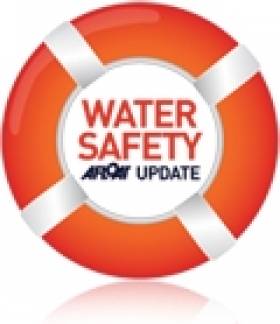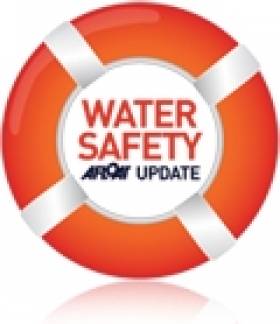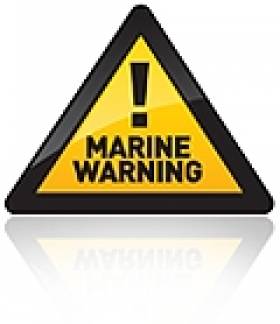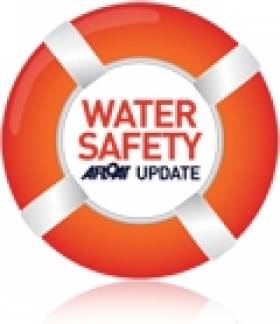Displaying items by tag: Marine Notice
Marine Notice: Alcohol and Drugs Onboard Pleasure Craft
#WATER SAFETY - The Department of Transport, Tourism and Sport (DTTAS) has published a Marine Notice addressed to all pleasure and recreational craft owners, masters and users to remind the public of the law in relation to being under the influence of alcohol and/or drugs when operating or being on board a vessel in Irish waters.
The 2010 Annual Report of the Marine Casualty Investigation Board (MCIB) highlighted the dangers inherent in excessive alcohol consumption while on board or operating a vessel and emphasised the relevant legislation under the Pleasure Craft (Personal Flotation Devices and Operation) (Safety) Regulations.
While operating a pleasure craft, being towed or on board any floating vessel, it is against the law to be under the influence of alcohol or drugs or any combination of drugs or of drugs and alcohol to such an extent as to be incapable of having proper control of the craft.
It is also against the law to consume alcohol or drugs in circumstances which could affect the safety of others on board or others using Irish waters, or create a disturbance on board or be a nuisance to others using Irish waters.
It is a requirement for the master or owner of a pleasure craft to take all reasonable steps to ensure that persons comply with the regulations.
The Maritime Safety Act 2005 also contains a range of provisions relating to the prohibition on operating a vessel in Irish waters while under the influence of alcohol or drugs, the breaking of which can lead to fines of up to €5,000 and up to three months' imprisonment.
Full details are outlined in Marine Notice No 56 of 2012, a PDF of which is available to read or download HERE.
#MARINE NOTICE - The latest Marine Notice from the Department of Transport, Tourism and Sport (DTTAS) draws mariners' attention to the official report on the sinking of the fishing boat Ainmire and its recommendations for safety on board all fishing vessels.
As reported in September last year on Afloat.ie, the report by the Marine Casualty Investigation Board found that a breach in the engine compartment caused the Ainmire to take on water and sink off the coast of Scotland in April 2011.
The report concluded that the failure of a sea water cooling pipe in the engine room was the most likely cause of the flooding, and noted that the pipework had not been renewed during the life of the vessel.
Investigators also noted that the bilge pump was located under the floor plates in the engine room as was this inoperable when the water level rose in the compartment.
Marine Notice No 58 of 2012 - a PDF of which is available to read and download HERE - reminds fishing vessel operators that large sea-water inlets in engine rooms make their boats vulnerable to severe flooding if they fail.
It is recommended that these pipes should be checked for corrosion every year, especially around the welded joint at the hull. Ultrasonic thickness testing of the pipework should also be considered.
Moreover, such pipework can be eroded quickly by stray currents, so electrical equipment should be checked regularly, while the location of bilge pumps in the engine room should be carefully considered
Marine Notice: Rock Installation Works Along Corrib Pipeline
#MARINE WARNING - The Department of Transport, Tourism and Sport (DTTAS) has been advised that subsea rock installation works will shortly commence along a pipeline route from the Corrib Gas Field in Broad Haven Bay off Co Mayo.
Works will commence in the middle of this month (October 2012) and are expected to be completed in 6-10 days. The operation will be carried out by the vessel Tertnes (Call sign PGAN). All vessels in the vicinity are requested to keep clear of the works as these works progress along the pipeline route and to comply with requests from work vessel.
Furthermore, all vessels are requested to monitor and comply with the Radio Navigational Warnings that will be broadcast for the duration of the works. All vessels involved in the operations will be listening on VHF Channel 16 throughout the project. All vessels are required to comply fully with the International Regulations for the Prevention of Collisions at Sea and to manoeuvre their vessels accordingly.
The attention of all is also drawn to Marine Notice No 17 of 2007, which gives general advice in relation to the activities of vessels engaged in survey work for hydrographic, seismic, fishing research and underwater operations.
Full details of co-ordinates for the current works are included in Marine Notice No 57 of 2012, a PDF of which is available to read or download HERE.
Marine Notice: Annual Servicing of Lifesaving Equipment
#MARINE NOTICE - The latest Marine Notice from the Department of Transport, Tourism and Sport (DTTAS) reminds vessel owners and all seafarers of the requirement to service their lifejackets, liferafts and other safety equipment.
All items that form part of a vessel's lifesaving appliances, from SOLAS and MED inflatable liferafts to inflated and rigid inflated rescue boats, inflated boats, inflated life jackets (including immersion suits complying with the requirements for lifejackets), hydrostatic release units (HRUs) and marine evacuation systems are required to be serviced at intervals not exceeding 12 months.
Annual servicing of inflatable liferafts, HRUs and marine escape systems must be carried out by an approved liferaft service station which has been formally appointed by the manufacturer of the approved equipment.
The names and contact details of the currently approved liferaft service stations in Ireland and which have been approved by the Minister for Transport, Tourism and Sport are listed in the appendix on Marine Notice No 53 of 2012, a PDF of which is available to read or download HERE.
Annual servicing of inflated lifejackets (including immersion suits complying with the requirements for lifejackets), inflated boats, inflated and rigid inflated rescue boats must be carried out by a service station which has been formally appointed by the manufacturer of the approved equipment.
Emergency repairs to a vessel’s inflated and rigid inflated rescue boats and inflated boats may be carried out on board that vessel, but permanent repairs shall be effected at a service station ashore as soon as practicable. This notice supersedes Marine Notice No 19 of 2010.
Marine Notice: Firing Exercises Off Gormanston & Survey Equipment in Galway Bay
#MARINE WARNING - Seafarers are advised to steer clear of upcoming surface-to-air firing exercises off north Co Dublin, as well as a survey equipment deployment operation in Galway Bay.
Marine Notice No 51 of 2012 outlines that the Defence Forces will be conducting live surface-to-air firing practices at Gormanston Air Defence Range in Co Meath this week on Wednesday 19 and Thursday 20 September from 11am to 3pm each day.
Similar to the exercises conducted this past July, an exclusion zone will be established comprising the land, air and sea areas contained within a radius of three nautical miles centred on Gormanston Aerodrome, with an additional segment centred on the aerodrime and bearing of 015 degree true through Mosney rail station and 106 degrees true through Gormanston rail station seawards for a distance of 10 nautical miles.
The exclusion zone D1 will be enforced by a Naval Service vessel. All mariners in the area are required to remain outside the exclusion zone while the range is active, and are recommended to carefully monitor the radio navigation warnings that will be broadcast throughout the firing period.
Meanwhile, in Galway Bay two Benthic Lander devices will be deployed between 24 and 26 September, to be recovered between 29 and 31 September.
The national research vessel R/V Celtic Voyager (call sign EIQN) - which will host the Science@Sea marine science training scheme this coming November - will carry out the deployment of the 2-3-metre high devices that will monitor sediment movement, current speed and direction, and wave motion at depth.
All vessels, particularly those engaged in fishing, are requested to give the vessel and wide berth of at least 500 metres and keep a sharp lookout.
Details of relevant co-ordinated are included in Marine Notice No 52 of 2012, a PDF of which is available to read or download HERE.
Marine Notice: Rock Placements Off Co Dublin & Buoy Deployments Off West Cast
#MARINE WARNING - The latest Marine Notices from the Department of Transport, Tourism and Sport (DTTAS) advise mariners to keep a look-out for rock placement off north Co Dublin and buoy placements off Co Mayo and Co Clare.
Operations were due to commence on Saturday 8 September at North Beach in Rush, Co Dublin for the placement of rocks offshore and in the Irish Sea for a period of 10-12 days weather permitting.
The works are being undertaken by DPFPV Tideway Rollingstone (call sign PHYR) and DPFPV Stornes (call sign PCKX) at various locations detailed in Marine Notice No 49 of 2012, a PDF of which is available to read or download HERE.
These vessels are operating on a 24-hour basis and will display appropriate days shapes and lights. They are also transmitting an AIS signal and will keep a listening watch on VHF Channel 16 for the duration of the works, which involve the deployment of survey ROVs and fall pipe that will restrict the vessels' movements. All mariners are instructed to give a wide berth.
Meanwhile off the west coast, ESB International has deployed two Waveroder buoys as positions near Achill Island in Co Mayo and Doonbeg in Co Clare.
The Achill buoy will be operational for a minumum of three months from now, while the Killard buoy will be operational for a minimum of 10 months having been recently relocated. Both are spherical and yellow in colour. All vessels are requested to give the buoys a wide berth.
Full details of their positions are included in Marine Notice No 50 of 2012, a PDF of which is available to read or download HERE.
Marine Notice: Undersea Cable Repairs Off Kilmore Quay
#MARINE WARNING - In its latest Marine Notice to mariners in the Irish Sea, the Department of Transport, Tourism and Sport (DTTAS) advises of cable repairs being carried out east of Kilmore Quay in Co Wexford.
Operations commenced yesterday 6 September and will continue till approximately next Thursday 13 September, subject to the weather. The works will be undertaken by C/S Peter Faber (call sign FLEV).
During repairs the vessel will be links to the seabed by the cable and will have poor manoeuvrability. This will be signalled with shapes and/or lights as required. The vessel will also broadcast regular safety messages to give details of activity and position.
All vessens in the area, especially those engaged in fishing, are requested to give a wide berth, and not to pass between the repair vessel and the shore.
Full details, including co-ordinates, are included in Marine Notice No 48 of 2012, a PDF of which is available to read or download HERE.
Marine Notice: Construction Work in Dingle Harbour
#MARINE WARNING - The latest Marine Notice from the Department of Transport, Tourism and Sport (DTTAS) advises on construction works at An Daingean Fishery Harbour Centre in Co Kerry scheduled to commence today 3 September 2012, weather permitting.
The works will take place at the mouth of Dingle Harbour, to the south east of Flaherty Point (co-ordinates: 52 07.235’ North, 010 15.711’ West) and will involve the installation of a new navigation beacon, five metres in height.
The works are being advanced by the Marine Engineering Division of the Department of Agriculture, Food and the Marine. The construction will involve use of a work vessel 20m × 7m in size carrying civil engineering plant and machinery, as well as other smaller work vessels and platforms. The work vessel will display the relevant day signals and navigation lights in accordance with the Collision Regulations.
For safety reasons, mariners are requested to proceed slowly and with caution in the approach to the entrance to Dingle Harbour and to give the works a wide berth. Wave-wash from vessels should be avoided.
These works are expected to be on-going until the end of October 2012, weather permitting.
Marine Notice on Legal Requirements for Personal Flotation Devices
#WATER SAFETY - The latest Marine Notice from the Department of Transport, Tourism and Sport (DTTAS) addresses the legal requirements for all recreational craft owners, masters and users in relation to the wearing and carrying of personal flotation devices (PFDs).
The notice discusses the different types of PFDs - lifejackets and buoyancy aids - and their performance standards, as well as highlighting the importance of their use, proper care and servicing for safe activities on the water.
The law makes clear that there must be suitable PFDs for everyone on board any pleasure craft, and that PFDs must be worn by anyone the deck of any craft or on board any open craft that is under seven metres in lengh - or for people under the age of 16, any craft regardless of length.
Also detailed are recommendations for the storage of PFDs, and guidance for their correct usage.
The use of lifejackets and buoyancy aids is particularly important in light of the recent Marine Casualty Investigation Board (MCIB) recommendations on a number of incidents where their availability could have saved lives.
Full details are included in Marine Notice No 45 of 2012, a PDF of which is available to read or download HERE.
Marine Notice: Recall of Mullion COMPACT 150N Lifejackets
#MARINE NOTICE - The Department of Transport, Tourism and Sport (DTTAS) has issued a Marine Notice (No 37 of 2012) advising of the recall of certain lifejackets manufactured by Mullion due to a potential problem with their inflation.
In order to avoid any potential safety issue, Mullion is recalling for inspection all COMPACT 150N ISO 12402 lifejackets which have been sold since 1 December 2011 if they have a yellow valve in the oral tube.
COMPACT lifejackets with a red valve in the oral tube are not affected by this recall.
Owners are warned not to use the affected lifejackets and to return them immediately to the nearest Mullion Lifejacket Service Station or the Mullion factory. See www.mullion-pfd.com/compact-life-jacket-recall-programme for more information.
































